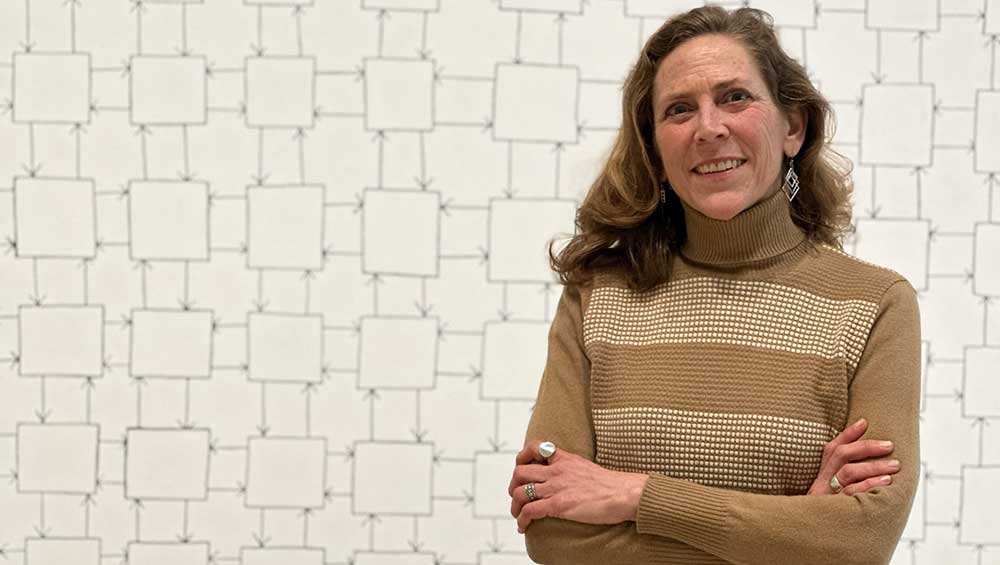
Leslie Jones, curator of Coded: Art Enters the Computer Age, 1952-1982, in front of Homeostat Drawing No. 1, 1969 by Stephen Willats. Photo: Claudine Dixon.
by BRONAĊ FERRAN
A landmark exhibition, Coded: Art Enters the Computer Age, 1952-1982, at the Los Angeles County Museum of Art (Lacma), has assembled more than 70 rarely seen works by artists, film-makers, musicians and poets that reflect aspects of the early stages of a “computer age”, from 1952-1982. A beautifully designed publication to accompany the event substantially extends the reach of the exhibition, with newly commissioned essays and informational resources, including a wider timeline, a bibliography and a list of previous exhibitions. It also has a checklist of works included in the exhibition. The project opens up new understanding of the influence of computational thinking as a conceptual catalyst within a shifting cultural and political zeitgeist of the postwar decades.
Shortly before its opening, Studio International spoke to the exhibition’s curator, Leslie Jones.
Bronaċ Ferran: What led you to develop this initiative?
Leslie Jones: It came about due to curatorial curiosity. In 2013, Lacma received a gift of 72 computer drawings from the estate of Frederick Hammersley. The material was unlike anything I had seen before (except for maybe typewriter drawings). Hammersley was involved in computer art for only about a year, but I was curious to learn about others who may have been working with computers so early on.
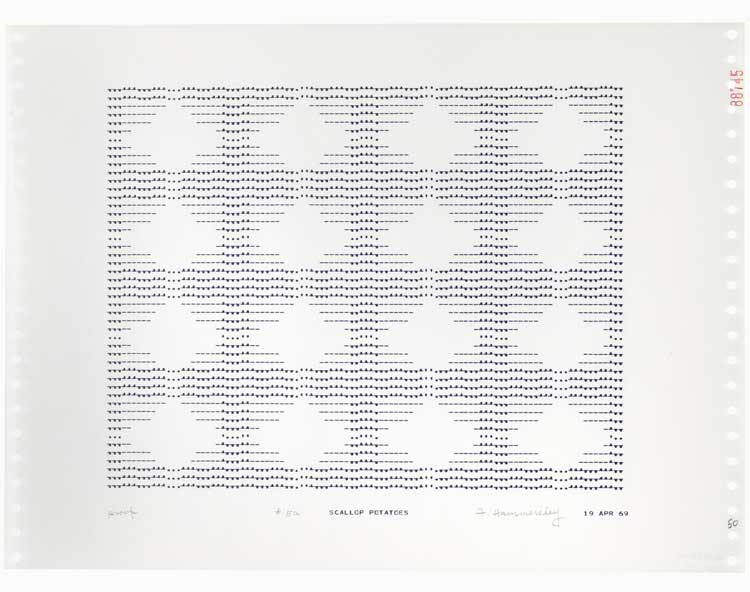
Frederick Hammersley, SCALLOP POTATOES, #50, from Suite of 72 Computer Drawings, 1969.
This led me down a rabbit hole, where I discovered a whole world of computer-generated art and artists who were working with the computer as a tool or inspiration. I am a sucker for an underdog (laughs) and it seemed to me that much of this work had been overlooked in the annals of art history and needed more recognition. I proposed the exhibition idea in 2013, so a decade ago now. It was scheduled to open in 2018 – marking 50 years since the Cybernetic Serendipity exhibition in London – as well as 50 years since Lacma first established an art and technology programme. But for various reasons it was postponed. Then came the pandemic. Anyway, it seems like now it is the perfect time to do it, given the increasing interest in contemporary digital art.
BF: How did you develop your curatorial vision for the exhibition?
LJ: I wanted to recontextualise the material, not to remarginalise it, by looking at it again “in its moment” and in relation to contemporaneous art movements such as Op and conceptual art, for example. I wanted to draw out themes such as the use of systems and algorithms, serial expression, the use of geometrical forms, and depersonalisation of the creative processes, all themes that existed in a range of different practices at the time and seem to relate to computer functionality. In turn, that offers a new way of looking at works by Sol LeWitt or Jennifer Bartlett, for example.
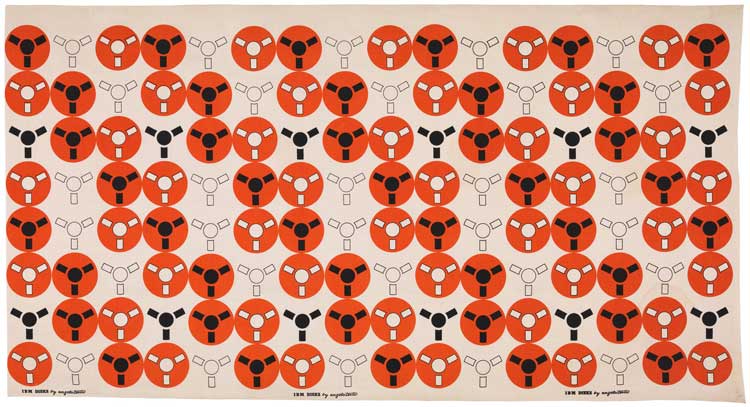
Angelo Testa. IBM Disks textile, 1952–56 (detail). Linen plain weave, screenprinted, 104 ¾ × 51 ¾ in (266.1 × 131.4 cm). Los Angeles County Museum of Art.
I suppose it is a zeitgeist argument, that we can recognise a sense of speculation about the computer’s potential that comes through in some of the works of the period. It was also important to me that the exhibition be interdisciplinary (in a similar way to Jasia Reichhardt’s approach with Cybernetic Serendipity). In fact, poets and musicians were among the first to experiment with computers for creative expression, as early as the 1950s. There is lots of text-based work in the exhibition as well as film, dance and music. (An exhibition playlist will be available to access in the gallery and on Lacma’s website.)
BF: What were the other challenges involved in bringing this idea to realisation?
LJ: Making the selection was the biggest challenge, as it always is with thematic group exhibitions. Seventy-five artists are represented but it could have been 175. We were limited to borrowing from private collections and institutions in the US, so that also affected what could be included.
The catalogue does try to remedy this by having a more expansive approach, including a chronology that includes additional key figures as well as notable historic events. Gustav Metzger, Ulla Wiggen and Robert Mallary are examples of artists I would have loved to have included in the exhibition, but was unable to for logistical reasons. I really hope the catalogue will serve as a sort of primer for further study and exploration. I have left lots of breadcrumbs for future scholars!
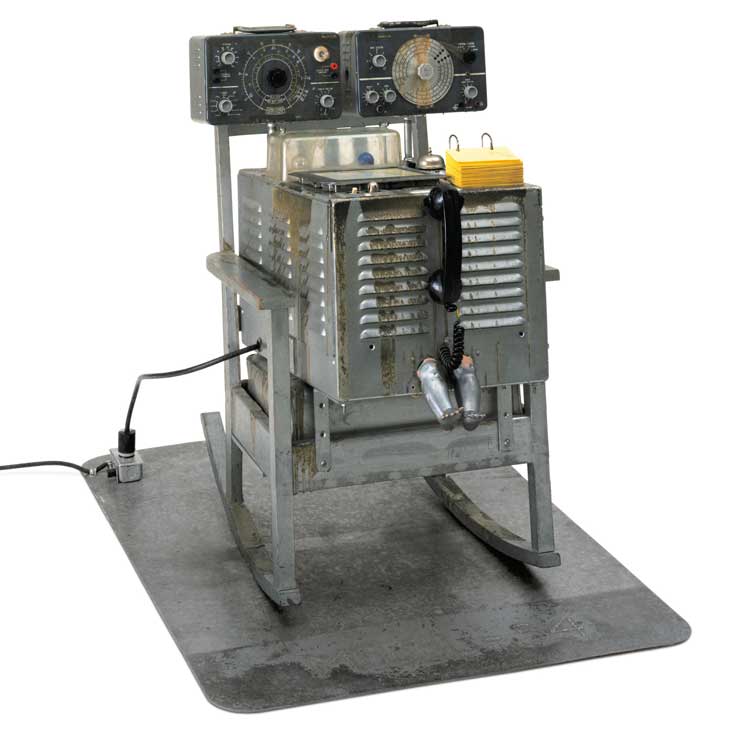
Ed Kienholz. The Friendly Grey Computer – Star Gauge Model #54, 1965.
BF: What do visitors see when they enter the exhibition?
LJ: There are six rooms and six themes. The first thing visitors will encounter is a sculpture by Edward Kienholz called The Friendly Grey Computer – Star Gauge Model #54” (1965), which is sort of my poster child. It’s centred in the first gallery, which is devoted to the computer and popular consciousness. No works in this gallery were made with computers, but they demonstrate the responses of artists who, like the general public, were coming to terms with this new technology. The potential of the computer generated expressions of wonder and awe as well as anxiety. Other works in this gallery include wonderful screen-prints by Eduardo Paolozzi from his Universal Electronic Vacuum portfolio (1967) that employ a “circuit board aesthetic”.
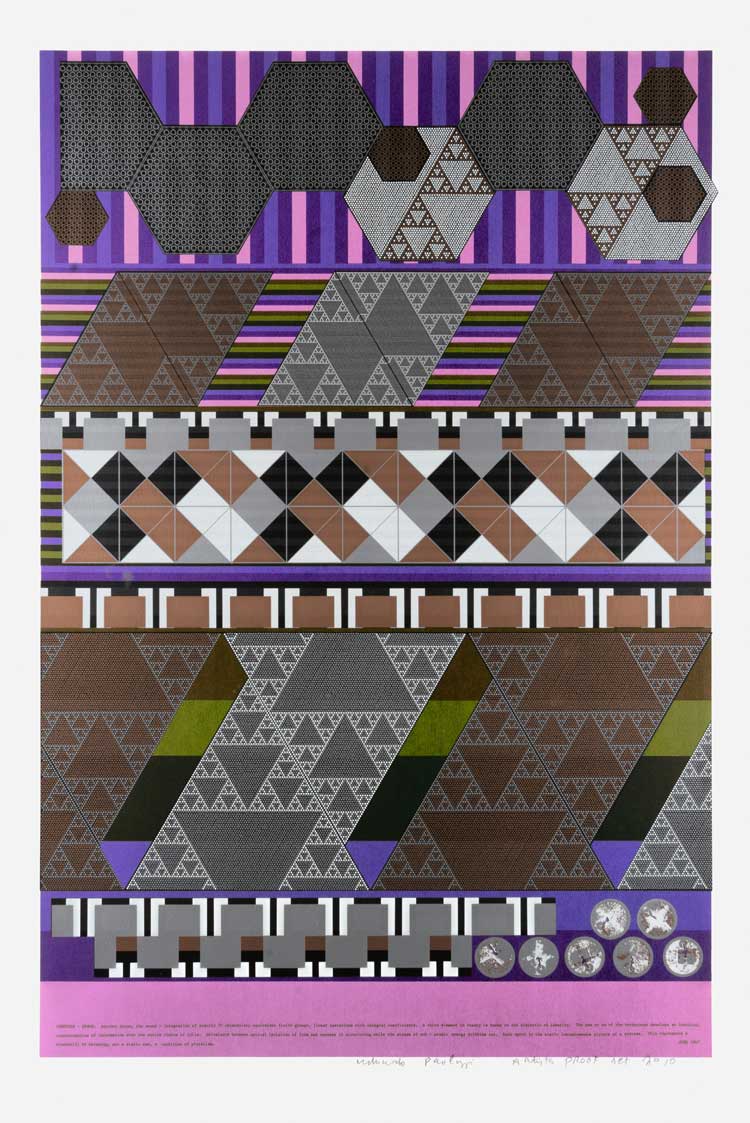
Eduardo Paolozzi. Universal Electronic Vacuum: Computer-Epoch, 1967. Ten screenprints,
each: 40 × 28 in (101.6 × 71.1 cm). University of California, Berkeley Art Museum and Pacific Film Archive, gift of Eduardo Paolozzi.
I would say there is a circuit board aesthetic, a punch-card aesthetic, as well as an interest in pristine and gleaming metallic surfaces, reminiscent of the IBM mainframe. An example is a large painting of a computer disk pack by Lowell Blair Nesbitt, a photorealistic painter. After seeing computers on view in an IBM showroom in New York, he thought they would make a spectacular series of photorealistic paintings.
The second gallery is devoted to mathematics and the beginning of computational aesthetics. Many early computer artists were interested in maths or were mathematicians themselves, like Frieder Nake. Basic mathematical forms were also the most easily programmable with the rudimentary systems of the time, so you will see lots of circles, squares and curves, as in Siah Armajani’s To Perceive 10,000 Different Squares in 6 Minutes and 55 Seconds, from 1970, for example. At the same time, many conceptual artists were interested in counting, so you also find these works included here.
In the third gallery, we shift to look at algorithms and how they were used by various figures, including in conceptual art by LeWitt as well as early computational artworks by Manfred Mohr. We have also included several early generative text-based works here.
The fourth gallery is called encoding art. It shows computer artists grappling with art history, by re-envisioning works by Piet Mondrian and Paul Klee, for example. Vera Molnár and her drawings inspired by Klee are exemplary in this regard. We also show Leon D Harmon and Kenneth C Knowlton’s large Computer Nude from their Studies in Perception in 1966 in this section. It was originally conceived as an office prank, but also seems to demonstrate a sort of “artification” of computer-generated art by reference to an odalisque. The work presented here captures the moment when the computer artists were trying to establish their place in art history, grappling with questions such as “Do we have a lineage” or “Is this something brand new?”
The fifth gallery addresses information as art/art as information. It looks at how artists at the time were collecting or generating data as an art form responding to social and political things going on in the world. Works by Sonya Rapoport and Hans Haacke are on view here.
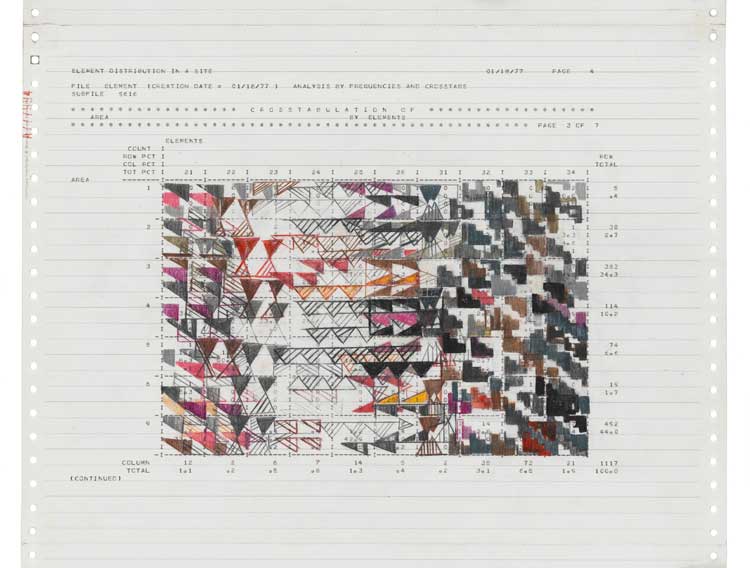
Sonya Rapoport, Anasazi Series II, 1977. Pencil, Prismacolor, coloured typewriter, and computer print on continuous-feed computer paper, open: 110 × 14 15/16 in (279.4 × 37.9 cm); closed: 11 × 14 15/16 in (27.9 × 37.9 cm). Los Angeles County Museum of Art.
The last gallery is dedicated to the computer and politics as well as “open scores”. There was a stigma associated with computers in the 1960s and 70s due to their associations with the military-industrial complex and large corporations. At the same time, a number of artists saw how computer programming and technology could be used to respond to the political situation or to engage with social issues.
In this gallery, we have included Charles Csuri’s Random War piece (1967) as well as Waldemar Cordeiro’s The Woman Who Is Not BBWaldemar Cordeiro’s The Woman Who Is Not BBWaldemar Cordeiro’s The Woman Who Is Not BB (A mulher que não é BB) (1971, printed 1973).
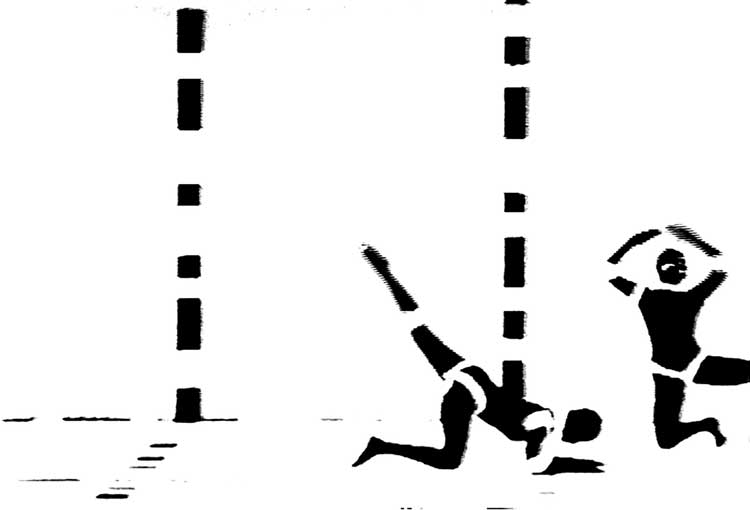
Analivia Cordeiro. still from M 3×3, 1973. Video (black and white, sound), 9 minutes, 54 seconds. The Museum of Modern Art, New York.
We are also showing Alison Knowles’ [computerised poem] The House of Dust here and we have a projection of Analivia Cordeiro’s video M3X3 (1973), across the room from the work on paper by her father [Waldemar].
The final gallery also features Stephen Willats’ Homeostat Drawing No 1 from 1969 that we have redrawn for this context (the original being part of the Tate collection in London). It looks great at 7ft x 9ft and fills half a wall. Willats is one of the British artists who is not well represented in US collections, so the drawing is presented alongside a vinyl treatment of his Life Net Encoder (1974) and an exhibition copy of his What Made Me Like I Am (1978/2023).
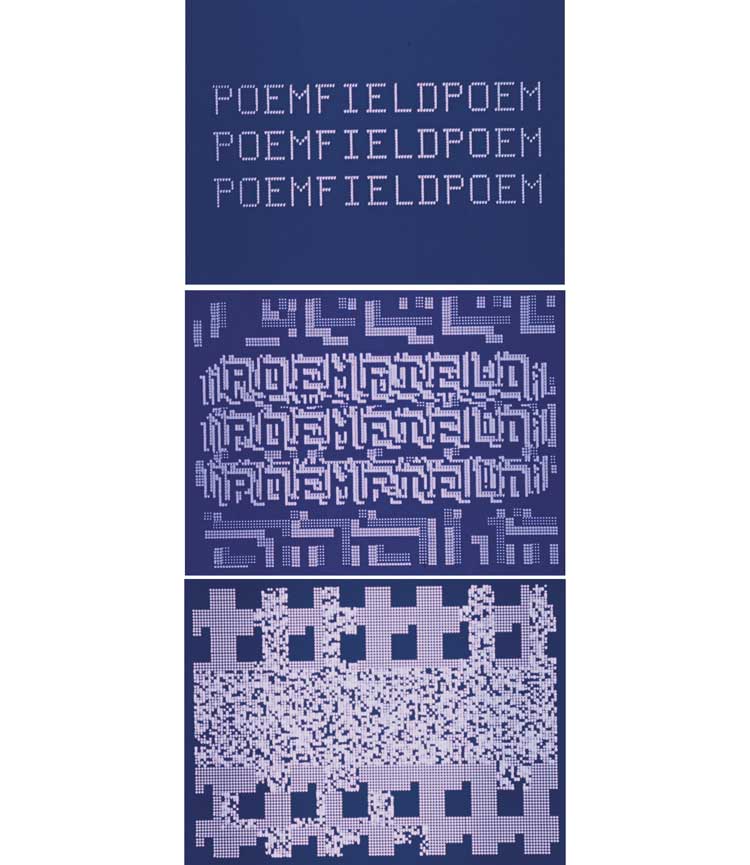
Stan VanDerBeek and Kenneth C. Knowlton. Poemfield No. 1 (Blue Version), 1967. 16mm film transferred to video, (colour, silent), 4 minutes, 41 seconds. Los Angeles County Museum of Art.
BF: That brings me to the question of formatting. Were there any challenges in approaching this?
LJ: Not really. In the early stages of mainframe computers, there were no screens and much of what was being produced by artists was realised on paper, using plotters or impact printers or microfilm. So, much of what we are showing existed on paper, so there was no need to reformat. I’ve also included some of the first screen-based practices and computer animations, such as Stan VanDerBeek’s Poemfield, including Poemfield No 1 (Blue Version), with input from Kenneth Knowlton from 1967, and John Whitney Sr’s Permutations, a 16mm film produced with an optical printer hand-built by Whitney in 1968. The one instance where reformatting was necessary was with an early digital piece by Rebecca Allen, who is based in LA. For the exhibition, she remade her “digitally native” Girl Lifts Skirt piece from 1974, since the original technology that she used is no longer available.
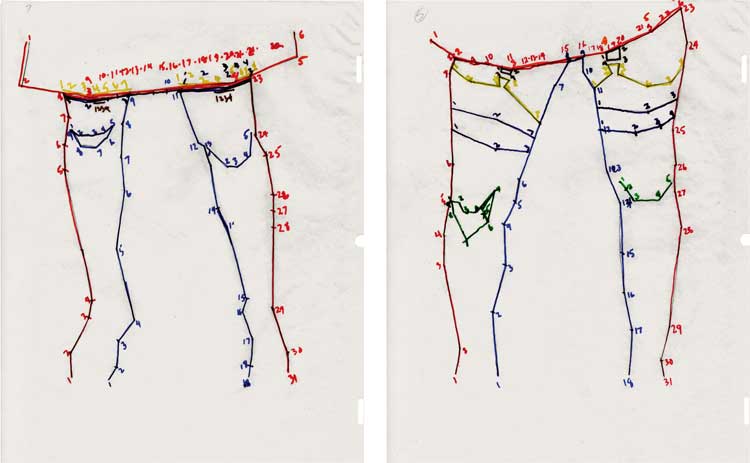
Rebecca Allen. Preparatory drawings for Girl Lifts Skirt, 1974. Graphite and marker on paper, each varying from 10 × 8 1/2 to 10 ⅞ × 8 ⅞ in (25.4 × 21.6 cm to 27.6 × 22.5 cm). Rebecca Allen, Los Angeles, and courtesy ZELDA Art Ltd, Birmingham, UK.
In conjunction with the exhibition, Lacma’s art and tech lab has commissioned a new work in two parts by the contemporary digital artist Casey Reas; the first part, entitled Metavasarely, will go live on the Lacma website the day the exhibition opens. It relates to a proposal made by Victor Vasarely to Lacma’s original art and tech programme, which ran from 1968 to 1972. Vasarely submitted it with IBM in mind as a corporate partner. Vasarely envisioned a sort of “picture-generating machine” involving circles with a grid of squares that could be used to generate an infinite number of different compositions, which could then be made into paintings or murals, for example.
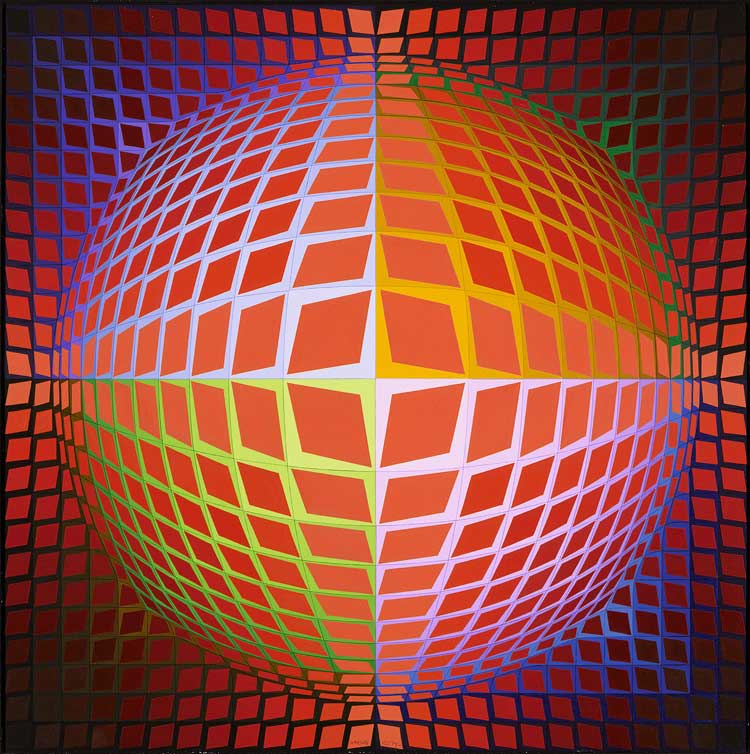
Victor Vasarely. Vega-Köntösh, 1971. Tempera on panel, 25 11/16 × 25 11/16 in (65.1 × 65.1 cm). Los Angeles County Museum of Art.
The estimated cost at the time was $2m, so like so many of the art and technology proposals, was not realised. Reas created a program to simulate Vasarely’s idea and has used that as the basis for an interactive online work. The second part of the commission is a new digital projection by Reas, titled An Empty Room, which will open at Lacma on April 9.
BF: Finally, what do you hope people might take away from the exhibition?
LJ: That is a great question. I would hope that people would learn not to be so quick to dismiss art made with new technology. If an artist sees potential in a new media, then others – especially curators and critics – should be open to that potential too. We need to learn from the past and give it a chance.
• Coded: Art Enters the Computer Age, 1952-1982, curated by Leslie Jones, is at the Los Angeles County Museum of Art [Lacma] until 2 July 2023. The accompanying book, Coded – Art Enters the Computer Age, containing new essays on aspects of the exhibition, a related bibliography, list of earlier exhibitions, the computer-inspired music playlist and more, co-published by Los Angeles County Museum of Art and DelMonico Books, New York, can be ordered here.
Click on the pictures below to enlarge